

|
Home Updates Hydros Cars Engines Contacts Links Builds by Steve Contact On The Wire |
|
|
Steve Betney AIRCARS |
PROP DRIVEN TETHERED CARS
This article is intended to give some history and insight into the type of tethered car most popular with beginners, particularly aeromodellers who dabble in four wheeled, ultra low flying control line models for the first time: airscrew driven cars. These can be either tractor or pusher propeller driven in configuration, examples of each will be illustrated.
The first British aircar published was the Aeromodeller Wasp in 1942, for R&G 6cc spark engine power, but this was not a very attractive lump really.
|
The car in the front of the image here is an original ED Aircar pusher car designed by Basil Miles, from a 1948 kit, powered by a Pennyslot 2cc diesel with an ED tractor prop put on back to front, as the sideport diesel runs well in pusher clockwise rotation as well as the normal anticlockwise direction. Kit production ceased after 1950, and unfortunately, no drawings are available for this car. The rolling chassis of the other car in the rear is my replica model of Miles’ 1948 MG Trophy winning spur geared car which I built a few years ago, which used some Aircar components. This was announced by ED in mid-’48 but never made it into production, so far as we have been able to trace. If anyone wants to build another replica, I can supply a faint copy of my scruffy working drawings if you send an SAE. An email copy of my construction article for it is available, and it is also covered in the Builds and Restorations section. |
|
|
|
The American Cleveland pusher aircar kit preceded the ED aircar by nearly a decade, and is quite attractive as shown on the image to the left. It was for an inverted O&R .23 spark engine power at the time, but this one runs really well on my old Eifflaender 2.49 Special diesel. Plans are available from Peter Hill (artypole@gmail.com). Cox, Wen Mac & other US manufacturers produced many complete .049 glow powered pusher and tractor aircars in the 1950s, and these appear on eBay for sale regularly. Search for "tether cars" if you want to see examples. Some of them need a bit of adjustment to work properly on the track; in particular, the tether bridle attachment points are not always in the correct place so that the car does not balance parallel to the ground in both horizontal planes when suspended from the apex of the bridle. |
|
A very simple pusher aircar called the Wind Wagon (no sniggers please….) was published by the well known US modeller Roy Clough in the Air Trails magazine during 1954, said to have clocked 62.8mph with a clapped O&R .19 spark engine forpower (seems a bit unlikely, but Clough was a venerated figure so maybe it did somehow). If you search for "Clough Wind Wagon" on www.rcgroups.com you can find a pdf download for the plan and build article. Don’t use pine as is recommended for the body, hard balsa will be easier and better, and a 2-2.5cc diesel ideal power. The Galeota Speedster tractor car was published in Model Engineer in the 1950s and is a very practical model, which runs well and reliably (Hugh Blowers own example regularly gives us a chance to have 40 winks when it runs for ever at Great Carlton). My model is shown below, and is powered by another Eifflaender Special 2.49cc diesel. The plan shows a plastic spinner for the body nose, but it looks better with it carved from the same wood block as the body. |
|
The own design red tractor car shown here is the only (Cox) .049 size car that I have built and dabbled with. I have to admit that I much prefer 2-2.5cc diesel powered models for ease of operation (and the better pong). If you do particularly want a small car, and a British one at that, the Vic Smeed Scuttler is a nice looking little design by the master modeller of ‘planes, cars and boats. Apologies for the poor quality of the only image of this that I could find, which can be seen below in good old black and white. Plans for this can be found from a number of sources, including Peter Hill (who has 12 aircar plans on his RRC list to choose from, discuss your preferred type with him for guidance).
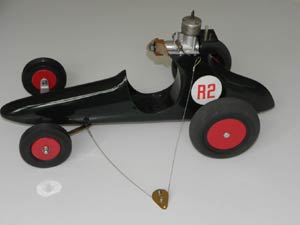 |
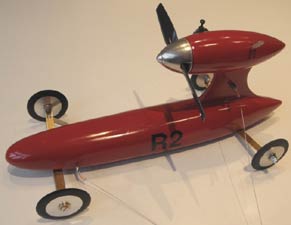 |
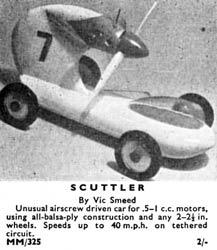 |
| Galeota | Cox engine pointing in right direction | Scuttler |
Scuttler is just the thing for a 1cc diesel engine. A wide variety of own design aircars have been made by RRC members in recent years in various materials and configurations. The RRC Great Carlton track speed record at c.62mph is currently held by Dick Roberts’ skeleton car built from aluminium rod and sections and is Oliver Tiger powered. Now that the worn out Olly has been rebored over the winter, we shall see if it can be persuaded to go at least a bit faster during the 2019 season.
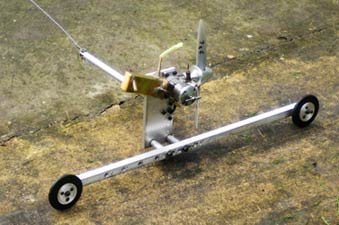 |
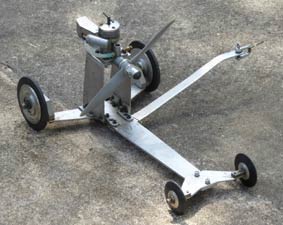 |
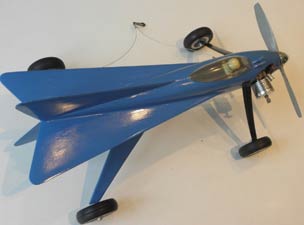 |
| Dick Roberts' record holder | PAW 'Lightweight' | 'Ollies Rocket' |
The image above shows the minimalist design, very well thought out, engineered, and very well tested now. Another all metal own design is the PAW Lightweight aircar shown centre, a 4-wheel configuration this time. My own (deceased) Ollies Rocket Racer was of a more traditional construction, but it clocked close to 60mph in the laps before it met its untimely end.
|
|
My replacement Dooling Rocket Racer to a similar design with a Dooling .29 for power will have to wait until the BMFA Buckminster hard circle becomes available, as the RRC Great Carlton track limit is 2.5cc engines. The work in progress, parts of this beast are shown here. It is based on a vintage American Harter magnesium speed control line model pan and has a custom made exhaust collector to save fumes going straight down onto the track. It should make quite an interesting sound and spectacle when it does finally run, at maybe c.80mph? Many weird and wonderful aircar designs from Eastern Europe have been tried over the years in the quest for speed, some with lifting wings to make them fly a bit, and examples of these can be seen from time to time for sale on eBay. (see below right) There really is huge scope for anyone to come up with their own interesting and innovative design and not just stick to the traditional. |
|
Speaking of the Buckminster hard circle, the great news is that the design now includes a smooth concrete annular track for tethered cars at the inner part of the tarmac control line circle, and also a large concrete pits and line park area for team race and speed control liners outside of the circle to avoid possible fuel damage to the tarmac over time. The latest Buckminster blog advises that the building contractor has had to be replaced, and that the location of the circle within the site is currently being finalised after noise trials. More news on this shortly hopefully, and a final fundraising push to get work started. If you fancy a great day out at Peter Hill’s track at Great Carlton near Louth in Lincolnshire to see tethered cars running, have a look at the RRC section here at onthewire for this year’s track days’ calendar and come along to see the fun; all interested folks are welcome. Just let Peter know you’re coming via email to his address given earlier, or via me at stevebetney@aol.com. |
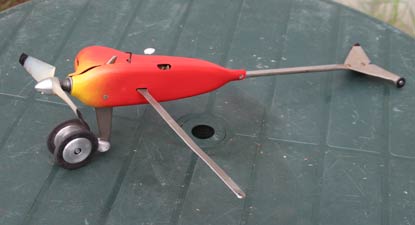 |
As well as other types including aircars, we shall be running new cars to the RRC 2019 2.5cc simple (no gears) formula. Have a look at the 'From the Pylon' narrative for April for my long and detailed article "Come in, Number 35" covering a simple design and construction approach to make such a car, and also Pavel Sarigins’ article on Russian 2.5cc diesel cars, which are also suitable for this class and available not too expensively via eBay for a quick way to get into the action this season. Once you’ve seen them running you’ll almost certainly be inspired to join in, or re-join if you’ve been away from cars for a while, and swell the ranks to keep the hobby circulating. Hope to see you at the track soon.
©copyrightStevebetney2020